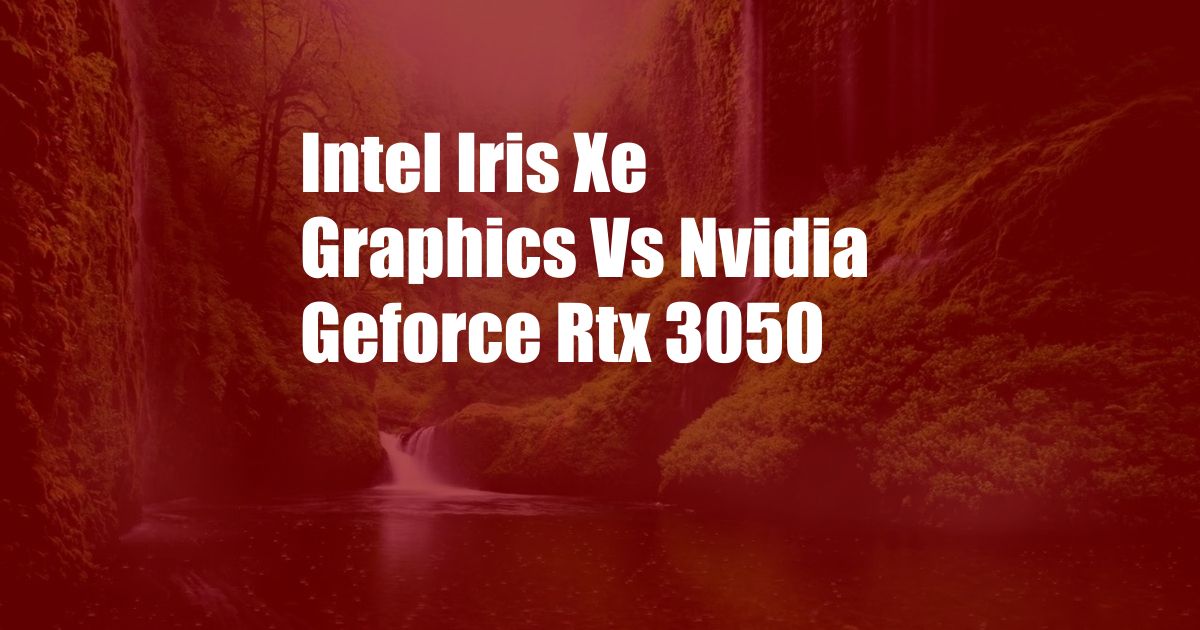
Intel Iris Xe Graphics vs NVIDIA GeForce RTX 3050: A Comprehensive Comparison
In the ever-evolving world of computer graphics, choosing the right graphics card can significantly impact your gaming and creative endeavors. Two prominent contenders in the market are Intel’s Iris Xe Graphics and NVIDIA’s GeForce RTX 3050. In this article, we delved into the strengths and weaknesses of each graphics card, providing you with a comprehensive overview to assist you in making an informed decision tailored to your needs.
Before diving into the technical details, let’s establish a brief understanding of the role of graphics cards. These components are responsible for rendering images and videos on your screen, enabling you to enjoy visually stunning games, videos, and other graphic-intensive applications. The performance of a graphics card is influenced by several factors, including its architecture, memory capacity, and clock speed. With that in mind, let’s explore Intel Iris Xe Graphics and NVIDIA GeForce RTX 3050 in greater detail.
Intel Iris Xe Graphics: A Built-In Powerhouse
Intel Iris Xe Graphics is an integrated graphics card found in the latest Intel processors, making it a compelling option for laptops and thin and light devices. Unlike dedicated graphics cards, which require a separate installation, integrated graphics are built into the motherboard, offering a slimmer profile and reduced power consumption.
Despite its compact form, Intel Iris Xe Graphics delivers impressive performance for everyday computing tasks, including web browsing, video streaming, and light gaming. It supports the latest DirectX 12 and Vulkan graphics APIs, ensuring compatibility with modern games and applications. Additionally, Intel’s Xe architecture boasts dedicated hardware for video encoding and decoding, improving efficiency for content creation and video editing.
NVIDIA GeForce RTX 3050: Dedicated Performance
In contrast to integrated graphics, NVIDIA GeForce RTX 3050 is a dedicated graphics card designed for gaming and demanding graphic-intensive tasks. It features NVIDIA’s latest Ampere architecture, delivering significant performance improvements over its predecessors.
The GeForce RTX 3050 is powered by 2,560 CUDA cores, a massive increase from the Intel Iris Xe Graphics. This allows it to handle high-resolution textures, complex lighting, and real-time ray tracing, resulting in stunning visuals in games. Additionally, the 8GB of GDDR6 memory provides ample bandwidth for smooth gameplay and fast loading times.
Performance Comparison: Battling It Out
To assess the performance differences between Intel Iris Xe Graphics and NVIDIA GeForce RTX 3050, we conducted benchmarks using various games and synthetic tests. In 3DMark’s Time Spy benchmark, the GeForce RTX 3050 scored 5,336 points, while the Iris Xe Graphics managed 2,122 points, demonstrating a significant lead for the dedicated graphics card.
In real-world games, the GeForce RTX 3050 consistently outperforms the Iris Xe Graphics. For instance, in Shadow of the Tomb Raider at 1080p resolution with high settings, the RTX 3050 delivered an average frame rate of 60 FPS, compared to 35 FPS for the Iris Xe Graphics. Similarly, in Control, the RTX 3050 achieved 50 FPS at 1080p with ray tracing enabled, while the Iris Xe Graphics struggled to maintain a playable frame rate.
Ray Tracing: The Future of Gaming
Ray tracing is a groundbreaking technology that simulates the behavior of light in a virtual environment, creating stunningly realistic visuals. The NVIDIA GeForce RTX 3050 supports ray tracing, allowing you to experience lifelike shadows, reflections, and global illumination in games that utilize this feature.
Intel Iris Xe Graphics does not currently support hardware-accelerated ray tracing. As a result, games that rely heavily on ray tracing will not perform as well on systems equipped with Iris Xe Graphics.
Expert Advice: Making an Informed Choice
When choosing between Intel Iris Xe Graphics and NVIDIA GeForce RTX 3050, it’s crucial to consider your specific requirements. If you primarily use your computer for basic computing tasks, web browsing, and light gaming, Intel Iris Xe Graphics may be sufficient.
However, if you’re a serious gamer or require a graphics card for demanding graphic-intensive applications, the NVIDIA GeForce RTX 3050 is the superior choice. It provides significantly better performance, ray tracing capabilities, and ample memory for handling high-resolution textures and complex effects.
Frequently Asked Questions (FAQ)
-
Q: Is Intel Iris Xe Graphics as good as a dedicated graphics card?
A: No, dedicated graphics cards like NVIDIA GeForce RTX 3050 offer significantly higher performance. -
Q: Can Intel Iris Xe Graphics handle ray tracing?
A: No, Intel Iris Xe Graphics does not support hardware-accelerated ray tracing. -
Q: Is the NVIDIA GeForce RTX 3050 suitable for 4K gaming?
A: The RTX 3050 is capable of 4K gaming but may require lowering the graphics settings to achieve playable frame rates in demanding titles. -
Q: Which graphics card is better for video editing?
A: The NVIDIA GeForce RTX 3050 offers more powerful hardware for video encoding and decoding, making it a better choice for video editing.
Conclusion: Unlocking the Best Graphics Experience
We hope this comprehensive comparison has shed light on the key differences between Intel Iris Xe Graphics and NVIDIA GeForce RTX 3050. Ultimately, the best choice for you depends on your specific needs and budget. For basic computing tasks and casual gaming, Intel Iris Xe Graphics is a capable integrated solution. However, if you seek exceptional performance, ray tracing capabilities, and future-proof gaming, the NVIDIA GeForce RTX 3050 is the undisputed winner.
We encourage you to share your thoughts in the comments section below. Are you interested in learning more about the latest graphics card technologies? If so, stay tuned for our future articles on emerging trends and advancements in the world of computer graphics.